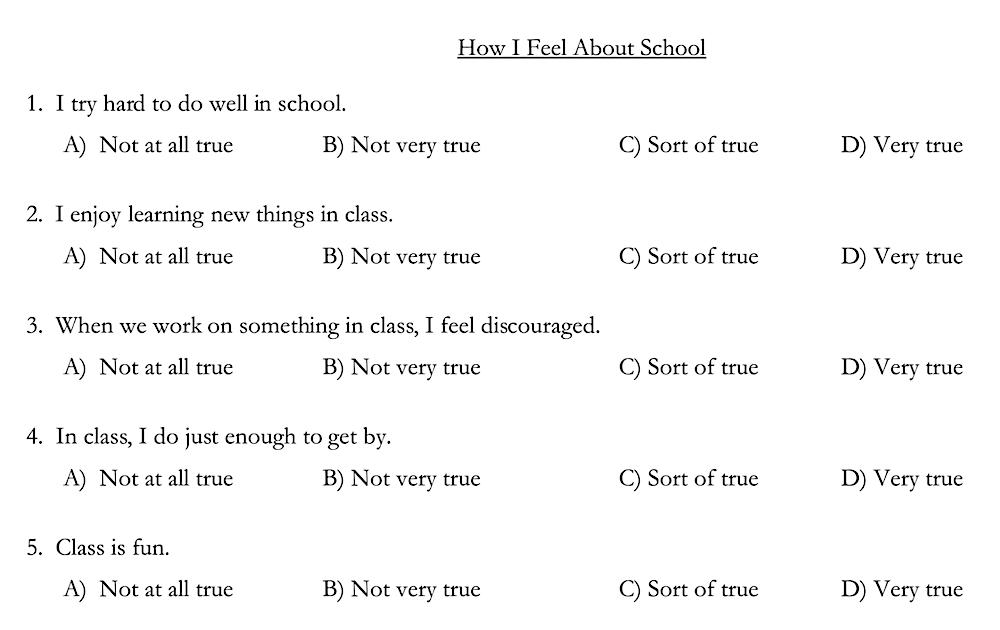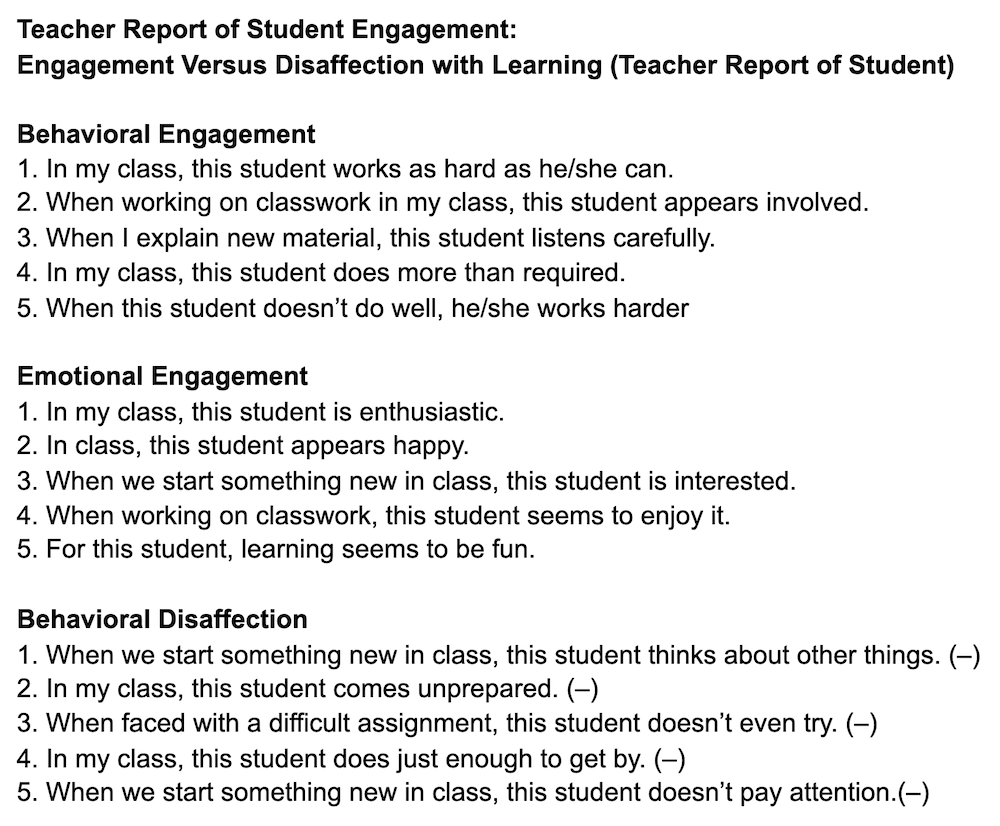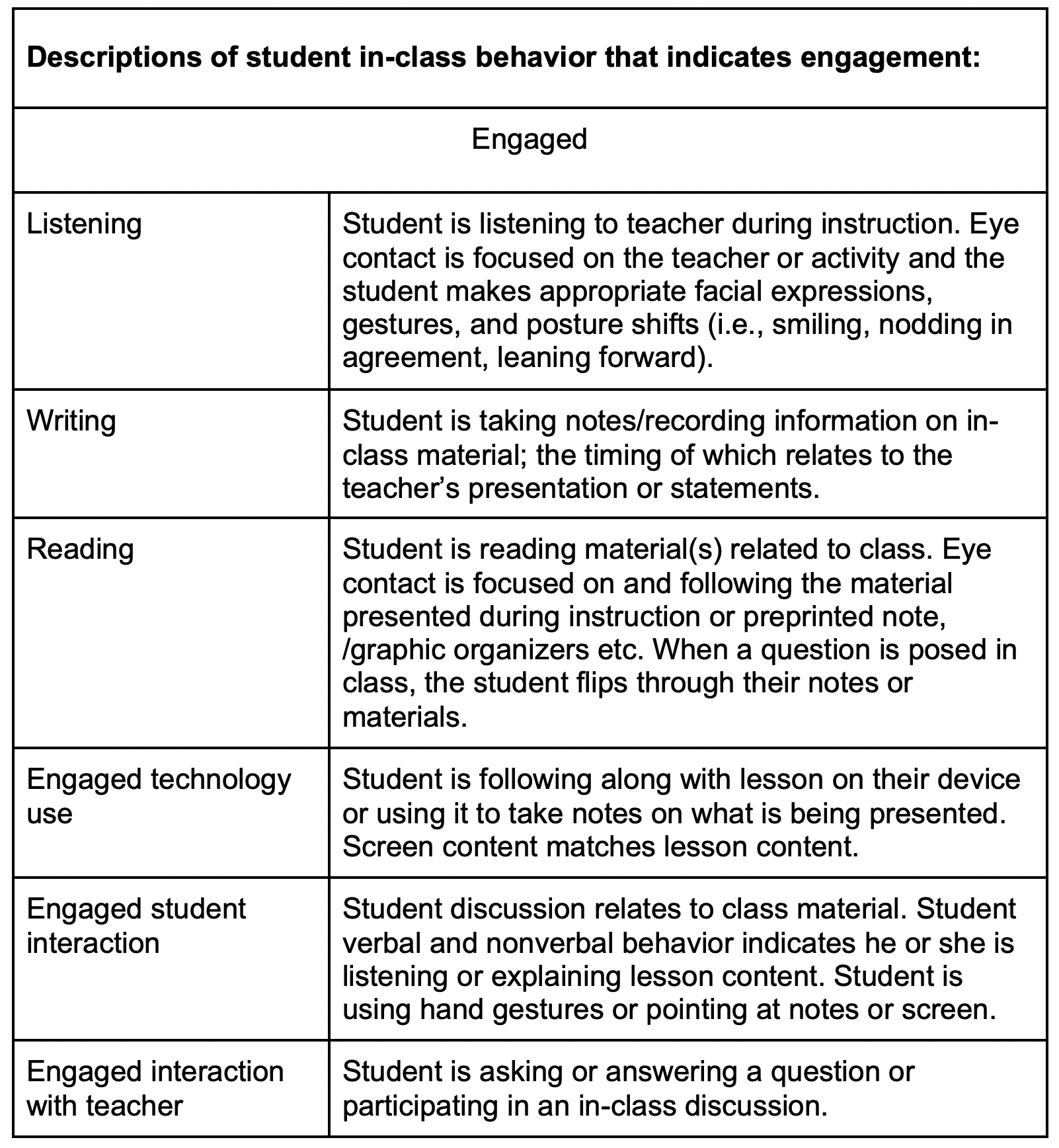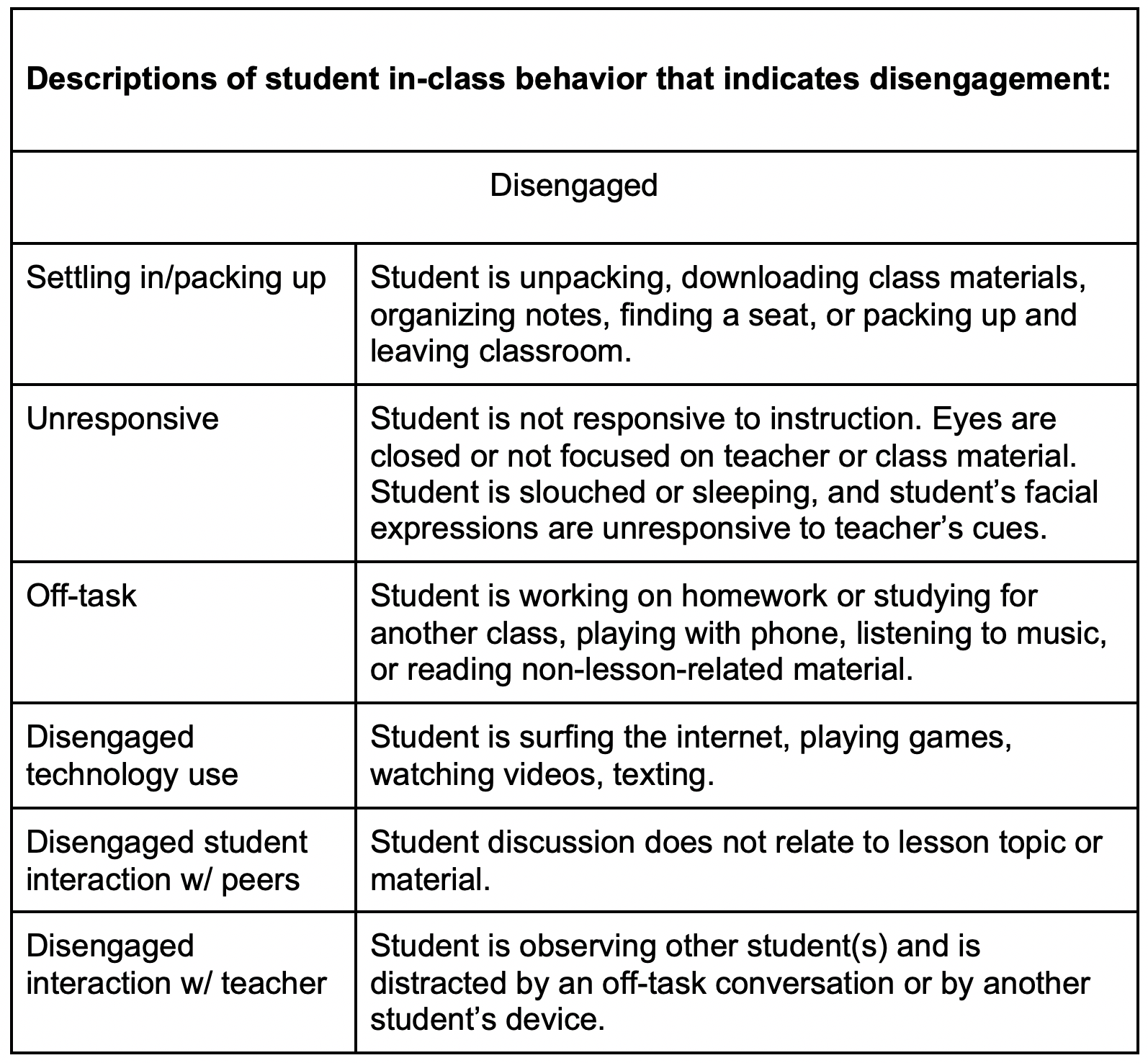Can Teachers Measure Student Engagement?
A MiddleWeb Blog

With one exception – the need for student engagement.
Over the past 20 years, student engagement has been singled out as one of the most important factors contributing to student success.
Higher levels of student engagement consistently lead to a range of short and long term positive outcomes — improved learning, achievement, persistence, retention, cognitive development, and a reduced risk of dropping out of high school or college (Bond, 2020).
What is student engagement?
One of the real challenges of student engagement, however, lies in defining it. As Dr. PJ Caposey recently wrote in Education Week…
Engagement…is almost universally accepted as something we want and need more of. What is nowhere near universally accepted is what student engagement looks like…As a result, multiple people are working toward different ends creating frustration, exhaustion, and lack of progress.
While various theories of motivation and engagement have gained – and lost – traction over the years, one of the most widely accepted is the theory proposed by Fredricks, Blumenfeld, and Paris in 2004. It presents engagement as a mash-up of behavioral, emotional, and cognitive factors.
► Behavioral engagement draws on the idea of participation and includes students’ involvement in academic, social, or extracurricular activities. This is the element considered crucial for achieving positive academic outcomes and preventing dropping out.
► Emotional engagement focuses on the extent of positive (and negative) reactions to teachers, classmates, academics, and school. Positive emotional engagement is presumed to influence students’ willingness to work and connection to school.
► Cognitive engagement is a student’s level of investment in learning; it includes being thoughtful and purposeful in school tasks and… being willing to exert the effort required to tackle complex ideas or difficult skills.
In simple terms, engagement is the degree to which students identify with and value what school has to offer and are willing to expend energy and effort to undertake the learning tasks put before them.
Is It Possible to Measure It?
If defining student engagement wasn’t enough of a challenge, then consider the difficulty of trying to measure it in a classroom setting.
I was recently asked by another educator to observe her class and offer a bit of feedback. Having done this countless times over the years as a mentor teacher, instructional coach, and preservice teacher supervisor, I was happy to do so. When I asked what in particular she was most interested in me taking a look at, her firm reply was “student engagement.”

I jotted down notes of which students responded to questions posed by the teacher. I tried recording the name of each student who offered up their own questions/comments to the class as well as who responded to a comment/question made by a peer. During individual and group work, I wrote down how many students appeared to be “on-task.”
The longer it went on, however, the less sure I became about my observations. At the end of class, despite my best efforts, it seemed like I was assembling a record of student participation…not student engagement.
Later that day the teacher asked me about what I had observed. I scratched my head, handed her my notes and sheepishly said, “the majority of your students were engaged…I think.” I offered up a few suggestions. Ultimately, however, I left with one pestering question looming overhead: just how can teachers accurately measure student engagement?
Asking Your Students

One way to gauge the degree to which your students are engaged is to simply ask, or in this case — survey them.
It turns out that student “self-report” measures are actually one of the most common methods used by researchers (and effective teachers) to accurately assess student engagement.
Quick surveys are practical and easy to administer in classroom settings, either on paper or using survey tools like Google Forms, Typeform, SurveyMonkey, and JotForm.
In this approach, students are provided carefully designed questions that reflect various aspects of engagement. Students are provided a questionnaire and then invited to select the response that best describes them. See this example.
There are a few concerns, however, about asking students about the level of their engagement.
- First, some students may not answer honestly under some conditions (e.g., if administered under the watch of a teacher or if they cannot do so anonymously).
- In addition, these surveys generally use questions that are broadly worded (e.g., I work hard in school) rather than questions that help teachers hone in on engagement in particular tasks and situations.
- One final drawback is that the majority of self-report engagement tools available to teachers tend to be general rather than subject specific (though there are a few that assess engagement in something more specific in math/science or reading).
Despite concerns, however, self-reported engagement surveys make it possible to collect valuable information about students’ subjective thoughts, behaviors, and attitudes instead of just collecting objective data on behavior, attendance or homework completion. Self-report methods also help provide insight into the emotional and cognitive elements of engagement which are not directly observable.
Using Teacher Ratings
Another method for assessing student engagement is for the teacher to complete a simple checklist or rating scale capturing their perception of each student’s engagement in the classroom. See this example. These “teacher reports” offer an alternative perspective on student engagement rather than just relying on the students’ perspectives.
This approach can be particularly useful with younger students, language learners, or students with limited literacy skills that make it challenging to complete a reading intensive self-report survey with multiple questions.
While there seems to be no agreed upon frequency for these teacher reports, the consensus is that “more data is better than less data.” The more often a teacher is able to rate their individual students’ engagement, the more information they collect and the better positioned they are to make comparisons with other students in the same (and other) classrooms.
It’s worth noting that some teachers and researchers recommend using a combination of both teacher ratings and students’ self reports of engagement – and then examine the correspondence between the two.
Keeping an Eye on Your Kids
Recently I came across a video report by the Wall Street Journal on how Artificial Intelligence (AI) is being used in China to observe, catalogue, quantify, and report on student engagement.
I’m not a big fan of robots watching my students or requiring them to wear headbands that indicate how much brain power is being exerted. There are, however, some less expensive (and far less spooky) ways to observe students that provide insight into engagement.
Direct observational methods are exactly what they sound like: watching students with an established protocol that focuses on student engagement. The person observing simply records whether a behavior was present or absent during a particular the moment in time. See this example.
Harvard, for instance, uses a version of the BERI (Behavioral Engagement Related to Instruction) chart below to observe – and gather information about – student engagement. I have changed the wording a bit for use with younger grades.
These observation charts can be used either with the individual student or at the classroom level to assess on- and off-task behavior as an indicator of engagement in academic tasks.
One concern with these types of observations is that they can be time consuming to complete and may require teachers/observers to collect data across various types of academic settings (i.e., group work, seatwork) to get an accurate picture of student behavior (Fredricks et al., 2011).
In addition, individual observations often provide limited information on the quality of effort, participation, or thinking. They can, however, provide details about the context surrounding higher or lower engagement levels.
Using Digital Tools to Monitor Student Engagement
In addition to the survey tools listed earlier, a variety of other digital resources are being used by teachers to help monitor student participation and engagement.
► PearDeck, ClassKick, and formative each allow teachers to pose questions to students, collect answers, and monitor in real time who has/has not responded. In addition, formative also permits students to respond to open-ended questions and submit hand-drawn responses.
► YoTeach! is a slick, easy-to-use real-time interactive tool that allows students to engage with each other and the teacher through polls, drawing, messages, and more. It also comes with student participation statistics to help educators see which students are participating the least/most.
► A number of gamified tools such as ClassResponder, Quizlet Live, Quizalize, and Kahoot all seek to encourage participation with a bit of fun and flare and allow you to compare your students’ answers classwide.
► I know a number of teachers who, rather than asking other teachers to observe their classroom, record classroom interactions for themselves and ask others to watch and analyze later on. Free and inexpensive tools like MoocNote, VoiceThread or Veed.io allow you to upload/capture a video file and then review and annotate on top of it with observations, feedback, and suggestions regarding student engagement.
Moving Forward
There is no shortage of concern among teachers, parents, administrators, and other school stakeholders about the need to boost student engagement. The first step, however, is for each of us to come to a better understanding of what engagement is – and what it isn’t. Once we have done so, the challenge remains about how to measure it.
Teachers can employ a variety of tools to gauge students’ cognitive, emotional, and behavioral connection to learning and to those around them. Through a balanced use of student surveys, teacher reports, observations, and maybe a few digital tools, we can move our students beyond mere participation and towards sustained investiture in school.






































Why did you not cite the source of your excerpts ?
Thank you for reading. All materials are linked to the source and/or included in the references found at the bottom of the article. Follow the link that says ‘Click for References” for the PDF. Materials created by me (Google Docs) are not included in the citations.
Hello Mr. Curtis Chandler, can I adopt your student engagement tool? I think the tool you developed is helpful to my current study regarding the relationship between Gamification and Student Engagement. Thank you so kindly!
Absolutely. Feel free to use, adapt, modify, etc. as you see fit. Here is a link for a template that you can modify.